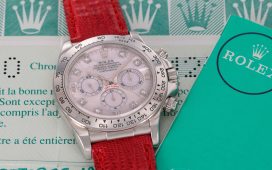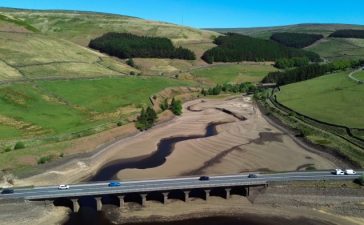On Wednesday, as part of its annual Geek Week, Sotheby’s will attempt to sell a 150mn-year-old treasure: a stegosaurus that was unearthed in Colorado last year, nicknamed “Apex”.
It is about 11ft tall and 27ft long, and impressively complete at between 79 and 83 per cent. It even includes portions of the skull — a particular rarity for this species as it is so small and fragile.
Sotheby’s estimates Apex is worth between $4mn and $6mn. “The chances of something that old surviving intact like this are so tiny given the impact on fossils of erosion, weather and tectonic shifts,” says New York-based specialist Cassandra Hatton, who runs the auctioneer’s science and popular culture division.
She compares the find favourably with better-known examples, including Tyrannosaurus rex skeletons, which are much more common. One reason for that is time: stegosaurus lived about 155mn years ago, more than twice as long ago as T-Rex. Hatton is unabashed in her boosterism. “I think this is not just probably the best stegosaurus ever found but one of the best dinosaurs found, period.” (Hence its boastful nickname.)
Only the auction results will show if such confidence is well placed but it will also test whether the rising interest in fossil collecting can continue.
Intact, impressive specimens such as this have been fetching record prices, such as the 38ft-long T-Rex skeleton nicknamed Stan, which sold for $31.8mn at Christie’s in 2020. Two years earlier, when Parisian auction house Aguttes offered up a similar skeleton — a fellow theropod, albeit of a yet-to-be-classified species — it fetched €2mn.
Celebrity involvement has helped pique interest: Leonardo DiCaprio and Nicolas Cage got into a bidding war over the skull of a dinosaur called a Tyrannosaurus bataar (Cage won that fight, agreeing to pay more than $276,000; what became of the skull we’ll get to later).

In 2018, in the wake of a costly divorce, Russell Crowe sold a mosasaur skull that he had bought from DiCaprio a decade earlier — for double what Crowe paid for it.
Hatton established her Geek Week in November 2018. It is programmed with lots that follow a simple mantra: “Whatever Cassandra loves, honestly.” While Hatton will sell other items under that banner, it’s the dinosaurs that consistently snare the highest bids.
In 2022, for example, her department offered an assortment of Buzz Aldrin memorabilia from the astronaut’s own collection, which earned $8.1mn overall. The single biggest sale of that week was the $6.1mn earned by the skeleton of a gorgosaurus, a late Cretaceous forerunner of the T-Rex.
$31.8mnHammer price for the T-Rex skeleton nicknamed Stan, sold by Christie’s in 2020
Hatton says the market has emerged as the profile of the world’s wealthy has shifted over the past 20 years. “It’s newer money, and these people tend to be interested in things that are different from art. They just buy what they love, and aren’t concerned about fitting in with a certain group of people — hip-hop artefacts, dinosaurs, spacesuits. Some of them may also buy art, but there’s a shift in taste.”
“Contemporary collectors are curious, have an open mind and a good eye for beauty,” says Roy Masin, the Netherlands-based dealer who runs Stone Gallery, which sells crystals, rocks and fossils. “They can really enrich a space,” he says.
Italian-born Iacopo Briano grew up following his father, a natural historian, around fossil digs, and has become one of the foremost brokers and auctioneers in Europe, working mostly with Paris-based house Giquello. He calls the recent boom, which started about five years ago, the third wave of interest in buying fossils.
The first, in the late 19th century, coincided with the construction of railways into America’s west, into what are now the states of Wyoming, Colorado and more; these regions remain rich seams for excavation today, as Apex shows. “Railway companies found dinosaurs poking out of the ground. It was heaven at the time,” Briano says.

Those bones mostly ended up either as part of roadside circus shows, often wrongly touted as giants’ leg bones or similar, or in the nascent collections of American museums (Andrew Carnegie was a major buyer). Interest ebbed in the 20th century until the 1990s, when the Jurassic Park movies reignited it, creating the second wave.
A few galleries, such as Dallas-based Heritage Auctions, dipped their toes into dino-selling around this time and saw success. Nothing was more seismic than the sale of Sue the T-Rex at Sotheby’s in 1997. The South Dakota find was estimated at $500,000, but sold for almost $8mn more than that.
It’s easy to see how collectors might be dazzled by dinosaur fossils — but they should be squinting at the fine print. So-called fossil poaching is a big issue as the money to be made increases — just ask Cage, who agreed to forfeit that skull after authorities determined it had been stolen from the Gobi desert in Mongolia.
The country is one of the world’s richest sources of fossils but export of them for commercial sale has been banned since 1924. It’s even illegal for researchers to make a cast of a dinosaur found in the country to keep in their overseas archives.
Bolortsetseg Minjin has made it her life’s work to fight to protect such finds. The Mongolian paleontologist lives and works in New York City, and established the Institute for the Study of Mongolian Dinosaurs 15 years ago to spearhead her efforts. “Anyone buying Mongolian fossils will lose money,” she says.

Other countries are equally stringent at blocking exports, including China, Brazil and Argentina. Avoid them at all costs, says Michael Triebold. He is the founder of Rocky Mountain Dinosaur Resource Center in Colorado and has been working as a fossil hunter for more than 35 years. “If you’re even thinking of buying a fossil from one of those countries, you’re a fool . . . Sellers will claim something was collected in the 1920s, way before the embargo. Bullshit.”
Note, too, that there are other quirky rules which affect fossil buying — mammoth material, for example, is banned in New York and California, as it falls under ivory embargoes, but can be acquired legally by Florida residents.
Would-be collectors, then, should proceed with caution when it comes to provenance. It’s safest to work with well-known finders, such as Triebold, who will readily share the GPS co-ordinates and drone footage of any fossil they are offering for sale. Ninety per cent of his business, he says, focuses on museums, with more than 300 institutions as customers. Still, he says interest from private collectors, keen to buy directly, is rising.
There is no legal definition of what constitutes a complete skeleton, Triebold adds, but buyers can request bone maps to show which parts have been filled in by 3D printing.
Every expert warns against treating fossils as an investment class. “We are in open waters. They’re more volatile than bitcoin,” says Briano. “When people approach me to go for an investment, I tell them to stick to the stock market. This is gambling.”
In part, it’s simply that there isn’t enough comparative data to allow pricing to be more than a finger-in-the-wind. “When you’re looking at an investment, you look at historic market trends. There aren’t any for dinosaurs,” adds Hutton.
The impact on pricing of deep-pocketed new institutions has skewed sales, too. Notably, Abu Dhabi’s Natural History Museum, which is primed to open next year. It turned out to be the buyer that spent more than $30mn on Stan the T-Rex.
For private collectors looking to dabble in the dinosaur world, though, Briano says that complete skeletons comprising at least 70 per cent of the bones are best, though the right components can make a 30 per cent complete specimen appealing — a skull, for example.
Triceratops is an in-demand find, and one that’s relatively common; one such skull will sell for between $300,000 and $500,000. “We can’t find enough of them for the requests we have,” he says. A single dinosaur tooth could cost just $100 or so, an ideal conversation-starter, or a full leg of a sauropod such as a brontosaurus or diplodocus at $20,000.
Then again, you could set out to find one for yourself. Kevin Jackson runs EXP Journeys, a luxury travel firm that specialises in adventure vacations. He has started offering palaeontology-themed trips to his customers in the US dinosaur zone — roughly, the Mountain Time Zone. It’s a niche Jackson only unearthed four years ago, when a client asked if he could organise access to a self-dig private ranch, where you can prospect for fossils like a miner might once have panned for gold. It costs about $1,500 per person per day, he says.
Be mindful, though, that it might become an obsession, as for one client who asked Jackson to plan a dinosaur digging trip for her teen son and his friends; she tagged along with a friend of her own. “The point was to go on a real dinosaur hunt. They got to go out with a paleontologist and they ended up discovering a new species of dinosaur, a skull that was [part of] a missing link,” he says.
At the end of the trip, rather than going home, she bought an Airstream trailer and parked it in the lot outside the lab where the skull was being studied. For the dinosaur enthusiast, a brief trip into the desert turned into a six-month stint of volunteering.











